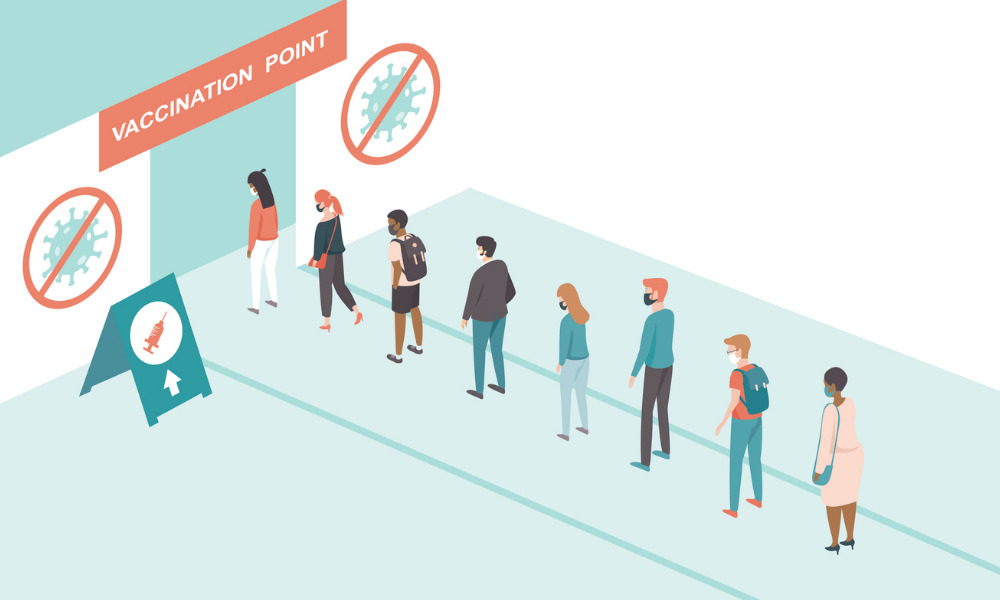Proactive development of internal vaccination and safety policies can prepare employers for bumps in the road during the vaccine rollout

The rollout of COVID-19 vaccines is part of the biggest mass immunization effort in history. It’s a monumental task for governments to manage and it has its challenges, but its success is key to the re-establishment of society and the economy.
Workplaces are one of the most common places where people gather, so employers have to prepare for the opening up of restrictions, employee safety, and the challenges that come with people who have varying levels of protection.
Different industries are going to have differing factors to address related to the nature of their work, so there is no one-size-fits-all approach to internal vaccination and safety policies for employers, says Tera Peterson, senior product marketing manager at risk management and compliance firm SAI Global, and employers are likely to encounter some challenges along the way.
In Canada, it may be difficult to require employees to get vaccinated due to privacy and human rights concerns, and vaccination during a pandemic is still a new area in employment law. Businesses with strict hygiene requirements or significant contact with the public may be in a gray area that has yet to be sorted out. At this point, it’s an employer-specific challenge that employers will have to carefully consider as they develop their policies, says Peterson.
Canadian HR Reporter recently spoke with Neena Gupta, a labour lawyer at Gowlings in Waterloo, Ont., about what employers can and cannot do when it comes to vaccines.
Accommodating reluctant and refusing workers
Where an employer can’t require employees to get vaccinated, it will have to consider alternatives for employees who refuse or want to delay vaccination, or if other employees express a reluctance to work with colleagues who haven’t gotten the shots.
This is where the importance of a clear, thought-out internal policy can be important, says Peterson. Such a policy should set out exceptions and alternatives — such as accommodation for unvaccinated employees by providing them with personal protective equipment, distanced work areas, and barriers separating vaccinated from non-vaccinated workers.
On the flip side, a company vaccination policy could include incentives to combat hesitancy — such as cash bonuses, time off, or recognition within the workplace — or make it easier to get the shot with paid time off or onsite vaccination clinics, she says.
“It depends on specific employers and their work culture, but the key is to have these scenarios set out and plan before employees return to work,” says Peterson. “That’s why I can’t stress enough the importance of having an end-to-end vaccine policy management plan.”
Some Ontario employers in COVID-19 hotspots are setting up on-site vaccination clinics for employees.

Tera Peterson
Having a plan in place before most employees return to work will make it easier to address various situations if and when they arise, as well as how to handle different types of employees. No employer has just one type of employee and a vaccination policy should recognize and address the scenarios for different employees, she says, referring to a restaurant, as an example, that may have a policy with different measures for waitstaff versus back-of-house employees.
Seventy per cent of hiring decision-makers in Canada believe that proof of vaccination against COVID-19 (such as a vaccine ID or vaccine passport) will be required in the near future for employees returning to the workplace, according to a survey.
Hybrid workplaces
While some employees are coming back to the workplace, others are not. Almost six out of 10 workers polled in October 2020 as part of Cisco’s Global Workplace Survey expect to be working from home at least eight days a month going forward, while an overwhelming 97 per cent want changes to make their work environment safer.
Will hybrid workplaces affect how employers should handle their internal vaccination policies? We’re still in the early stages of figuring that out, says Peterson.
Employees who work from home may still have to come into the office occasionally, so employers will have to be prepared, particularly if any of them were accommodated with remote work because they haven’t been vaccinated. Employers should reach out and do a pulse check with employees on whether they feel safe coming back and build arrangements into their policies — specific cubicles for remote workers to use when they come in, staggered attendance, safety measures in shared spaces, and testing requirements for vaccinated and non-vaccinated employees.
“It’s really going to be important for companies to become more organized, reach out, and understand the specifics of whether or not employees have to be physically present and take into consideration safety and what areas in which people can convene or collaborate,” says Peterson. “There’s going to be a huge paradigm shift and employers have to be more proactive about how they’re going to address, manage, and communicate it.”
It’s still early in the pandemic recovery and there’s a lot to be figured out in the area of employee vaccinations and their role in a safe workplace. But employers need to be proactive from both a safety and a legal standpoint so they’re not playing catch-up when the dust settles, she says.
“We’ve seen an increase in the momentum among some employers with employees returning to the workplace and asking for help with vaccine policies,” she says. “Being able to categorize your workforce, customize your policies, and slice and dice your data will really help you determine how successful you are at getting your employees and your business back in operation.”
More than half of U.S. workers support employer-mandated vaccination against COVID-19, a survey has found.




